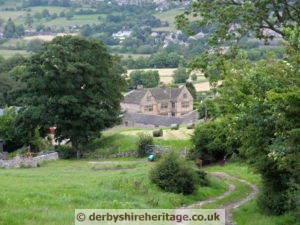Snitterton Hall was described by Pevsner as ‘a gem of an Elizabethan Manor House’.
At the time of the Domesday book, in 1086, Snitterton Hall near Darley Dale was part of the King’s Manor of Matlock and by the early twelfth century was held by Fulcher, second son of Sewalls of Ettington, founder of the Shirley and Ireton families. It is believed that the probable date of the current house is around 1631 and it may well have been built by Col John Milward. Milward was well-connected, ambitious and styled his house to reflect this. Constructed from Ashover Grit from Oaker Hill which lies half a mile to the North of the house.
On his death in 1670 Milward left the estate to his third (only surviving son) Henry and a life interest in part of the Snitterton lands to the natural son of the eldest son, John, who had died the year before without legitimate issue. This was George, on whose death in 1711 without issue, it reverted to Henry Fearne of Parwich, who had purchased the remainder from Henry Milward’s heir, Charles Adderley, married to his sister Felicia. He was the son of Sir Charles Adderley of Hams Hall, Warwickshire. Elizabeth, daughter and heiress of Fearne, married Edmund Tudor of Stoke Rochford whose descendant in the fourth generation, Edmund died in 1903, leaving it in the hands of Trustees, who eventually sold it to the McCreagh-Thornhills.
Snitterton Hall was let as a farm from 1816 throughout the nineteenth century. It was then the home of Col. B.G. Davie (married to the heiress), who sold it to the Bagshawes when he inherited Stanton Hall. Francis, sister and heiress of W.M.C Bagshawe brought it to Ernest Carver, who assumed the surname and arms of Bagshawe and on his death in 1936, it came to Maj. Francis Ernest Gisborne Bagshawe, on the death of whose widow in November 1986, it was placed on the market and sold for £200,000 to the writer Adrian Woodhouse. After extensive documentary research he began restoration of the house and its gardens and ten years later in 1996 the house was bought by a Sheffield property developer, Paul Caplan, who undertook extensive work on the house and gardens until selling the property in 2008.
During Snitterton Hall’s restoration, the entire roof was removed and the timber which was riddled with deathwatch beetle, wet and dry rot, was either restored or replaced with 17th Century oak timber.
The original lime ash attic floors were restored and plasterwork throughout the building was replaced with authentic clay, straw and lime mix.
The exterior stonework, in parts damaged through age and atmospheric pollution, was protected using a special micro-porous resin and the gardens were restored to the late Elizabethan-Jacobean style with extensive terraces and lawns and formal box hedging.


